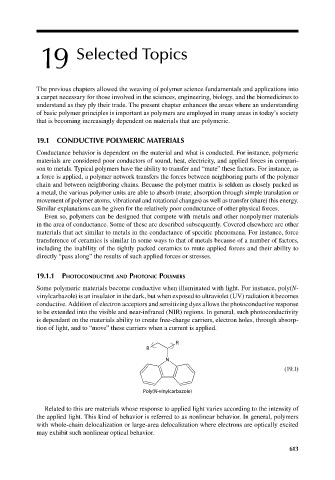Page 650 - Carrahers_Polymer_Chemistry,_Eighth_Edition
P. 650
19 Selected Topics
The previous chapters allowed the weaving of polymer science fundamentals and applications into
a carpet necessary for those involved in the sciences, engineering, biology, and the biomedicines to
understand as they ply their trade. The present chapter enhances the areas where an understanding
of basic polymer principles is important as polymers are employed in many areas in today’s society
that is becoming increasingly dependent on materials that are polymeric.
19.1 CONDUCTIVE POLYMERIC MATERIALS
Conductance behavior is dependent on the material and what is conducted. For instance, polymeric
materials are considered poor conductors of sound, heat, electricity, and applied forces in compari-
son to metals. Typical polymers have the ability to transfer and “mute” these factors. For instance, as
a force is applied, a polymer network transfers the forces between neighboring parts of the polymer
chain and between neighboring chains. Because the polymer matrix is seldom as closely packed as
a metal, the various polymer units are able to absorb (mute; absorption through simple translation or
movement of polymer atoms, vibrational and rotational changes) as well as transfer (share) this energy.
Similar explanations can be given for the relatively poor conductance of other physical forces.
Even so, polymers can be designed that compete with metals and other nonpolymer materials
in the area of conductance. Some of these are described subsequently. Covered elsewhere are other
materials that act similar to metals in the conductance of specific phenomena. For instance, force
transference of ceramics is similar in some ways to that of metals because of a number of factors,
including the inability of the tightly packed ceramics to mute applied forces and their ability to
directly “pass along” the results of such applied forces or stresses.
19.1.1 PHOTOCONDUCTIVE AND PHOTONIC POLYMERS
Some polymeric materials become conductive when illuminated with light. For instance, poly(N-
vinylcarbazole) is an insulator in the dark, but when exposed to ultraviolet (UV) radiation it becomes
conductive. Addition of electron acceptors and sensitizing dyes allows the photoconductive response
to be extended into the visible and near-infrared (NIR) regions. In general, such photoconductivity
is dependant on the materials ability to create free-charge carriers, electron holes, through absorp-
tion of light, and to “move” these carriers when a current is applied.
R
R
N
(19.1)
Poly(N-vinylcarbazole)
Related to this are materials whose response to applied light varies according to the intensity of
the applied light. This kind of behavior is referred to as nonlinear behavior. In general, polymers
with whole-chain delocalization or large-area delocalization where electrons are optically excited
may exhibit such nonlinear optical behavior.
613
9/14/2010 3:43:45 PM
K10478.indb 613 9/14/2010 3:43:45 PM
K10478.indb 613

